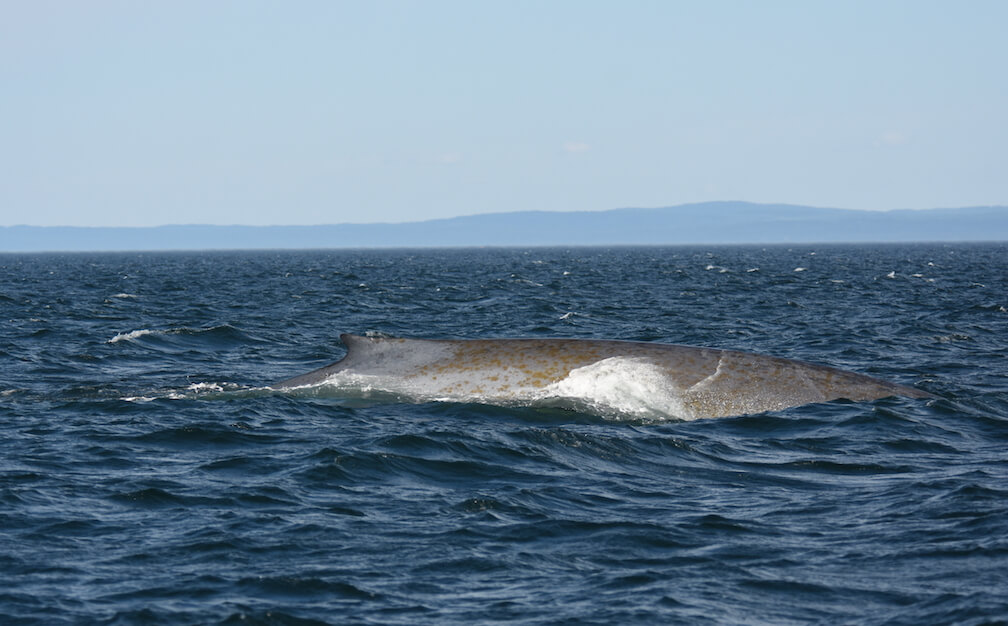B335
Blue Whale


-
ID number
B335
-
Sex
Male
-
Year of birth
Unknown
-
Known Since
1996
Distinctive traits
As with all blue whales, B335 can be recognized by his pigmentation pattern, which has little contrast. B335 also has a straight dorsal fin.
Observations history in the Estuary
Years in which the animal was not observed Years in which the animal was observed
Latest news from the publications Portrait de baleines
Photographed on August 1 by a naturalist and the GREMM research team, blue whale B335 is now in his seventh season in the St. Lawrence Estuary. Part of the Mingan Island Cetacean Study (MICS) catalog, this male has been known since 1996. In 2007, B335 was reportedly spotted by MICS in the midst of a “rumba” off Les Escoumins. This intriguing behavior generally involves two males racing behind a female in an attempt to get as close to her as possible. B335 eventually swam away after about twenty intense minutes, leaving the other male near the female. However, it is not known whether these competitive sessions between males lead to mating between the winning individual and the female. Which female was B335 swimming after in 2007? Drum roll… It was Pleiades (B197), who was also present in the estuary a few days ago—and the star of last week’s edition! At the time of writing, some 15 blue whales have been identified in the St. Lawrence Estuary for the 2025 season. Initial prey surveys conducted by Parks Canada report a marked abundance of krill in the Saguenay–St. Lawrence Marine Park area. Since blue whales feed mainly on this small pink crustacean, we hope they will find plenty to eat this summer!
B335 is one of the blue whales included in the photo-identification catalog of the Mingan Islands Cetacean Research Station (MICS). This individual can be recognized by his straight dorsal fin and low-contrast coloration pattern. This year, numerous colonies of diatoms can also be seen on his flanks. Each of these microscopic algae is composed of a single cell lined with a double envelope of silica, a “glass cage” of sorts, which explains why these colonies shimmer in the sunlight as if brass plates were placed on them. Diatoms are an important part of phytoplankton, providing food for krill, which in turn provide food for blue whales. The presence of these algae on his skin should not harm the animal.

B335 was tagged with an Argos-type satellite beacon in 2015, as part of a blue whale migration tracking project conducted by MICS, the Alaska SeaLife Center and Fisheries and Oceans Canada. From the Estuary, the blue whale had passed north of the Magdalen Islands before moving off into the Cabot Strait.
In recent weeks, we have received reports of blue whales swimming in pairs. In early autumn, blue whales in the St. Lawrence sometimes form more or less stable pairs, lasting several days or even weeks. Thanks to photo-identification and biopsies, MICS researchers have been able to observe that this is most often a male-female duo. These pairs could be a precursor to reproduction in these animals, which takes place in late autumn or winter. Occasionally, a second male joins the duo and the three individuals take part in what is known as a rumba; the female swims in front and the two males compete to be closest to her. After a race, which can last several hours, one of the males abandons the race and the other becomes the female’s escort. Do these pairs really result in reproduction of both individuals? A difficult question to answer in the short term!

In late August 2007, blue whale specialist Richard Sears witnessed a “rumba” scene involving B335 off Les Escoumins. This male had entered into competition with B185, who was calmly following the female B197, known as Pleiades. For 24 minutes, B335 raced against B185. Pectoral fins, tail tip, snout, raised body: water spurted in sprays all around the trio. Eventually, B335 pulled away from the pair. Had he tried his luck later?
In 2016, MICS collaborator René Roy photographed B335 trolling or swimming alongside female B476. Will he find a female this year? Your observations will tell us!
